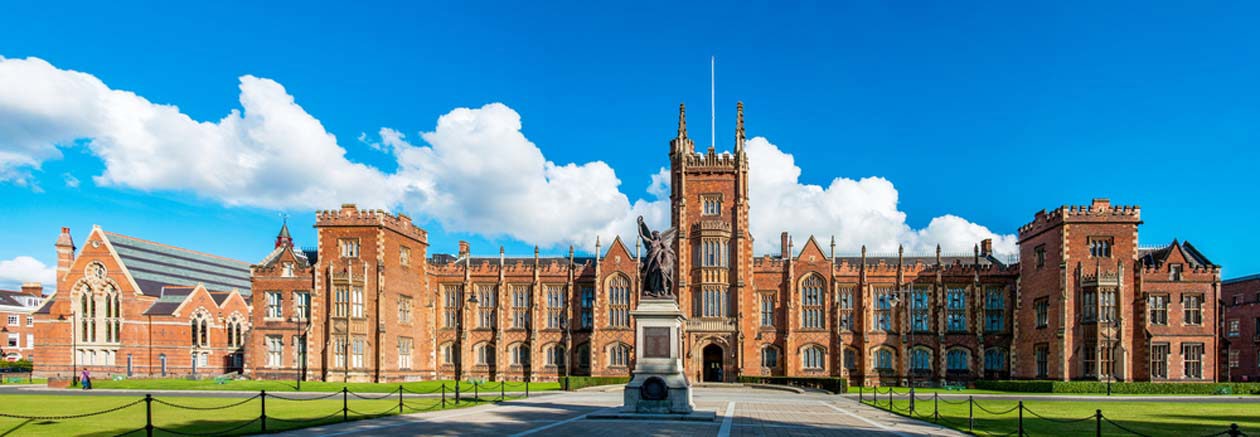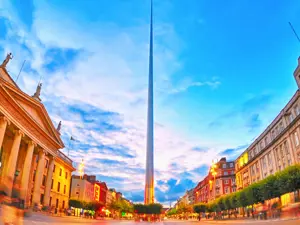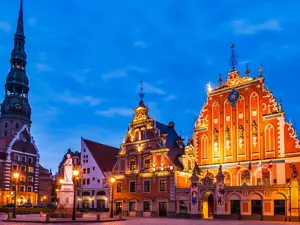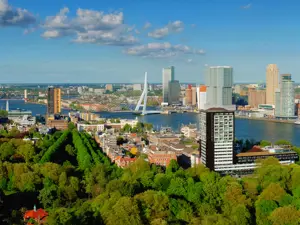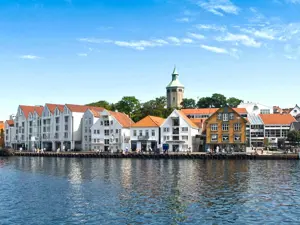The most welcoming capital of Europe
Belfast is an elegant port city, famous for its ship building, but also a cradle of typically Irish traditions with a positive dynamism that gives it an atmosphere rich in human values.
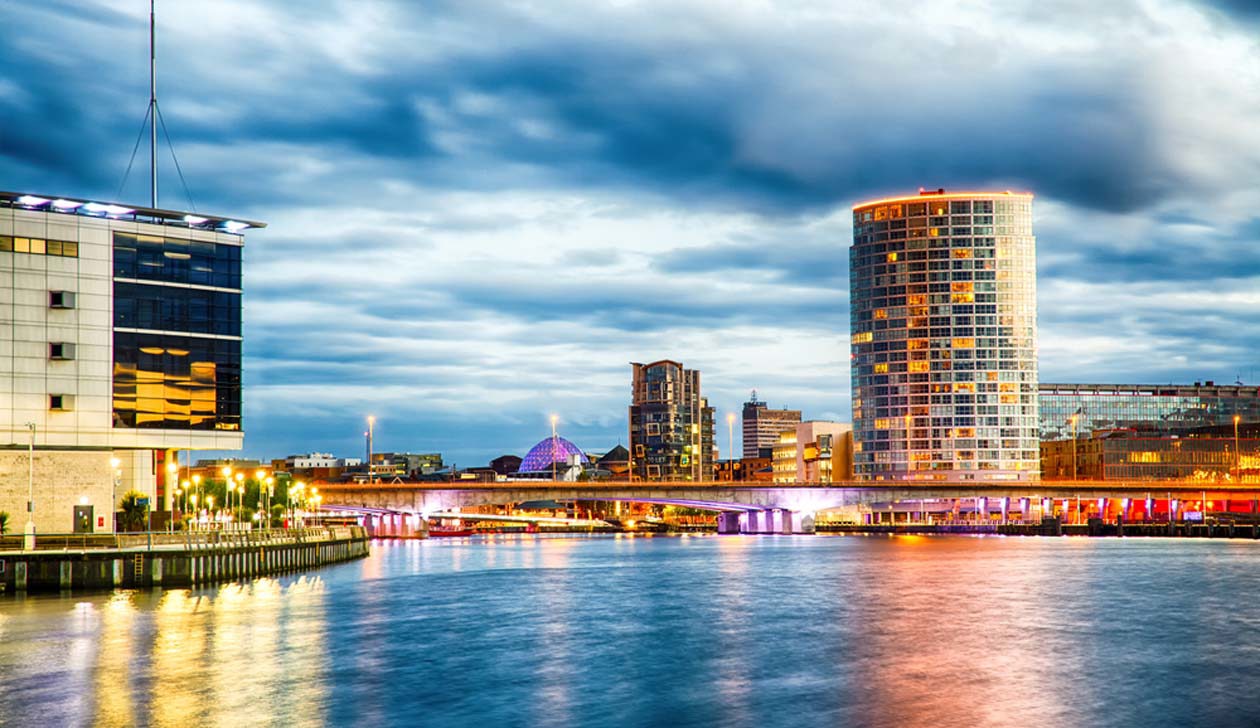
Belfast. Photo: Sisterscom.com, Shutterstock
This is Belfast, a city that likes to call itself “the most welcoming capital of Europe”, always ready to welcome passengers that arrive on cruise ships, and invite tourists to take a trip on the typical river boats or jump on a bike and explore the surrounding countryside to the top of Cave Hill, a mountain that offers an extraordinary panoramic view of the eastern part of the city.
Waterfront Hall
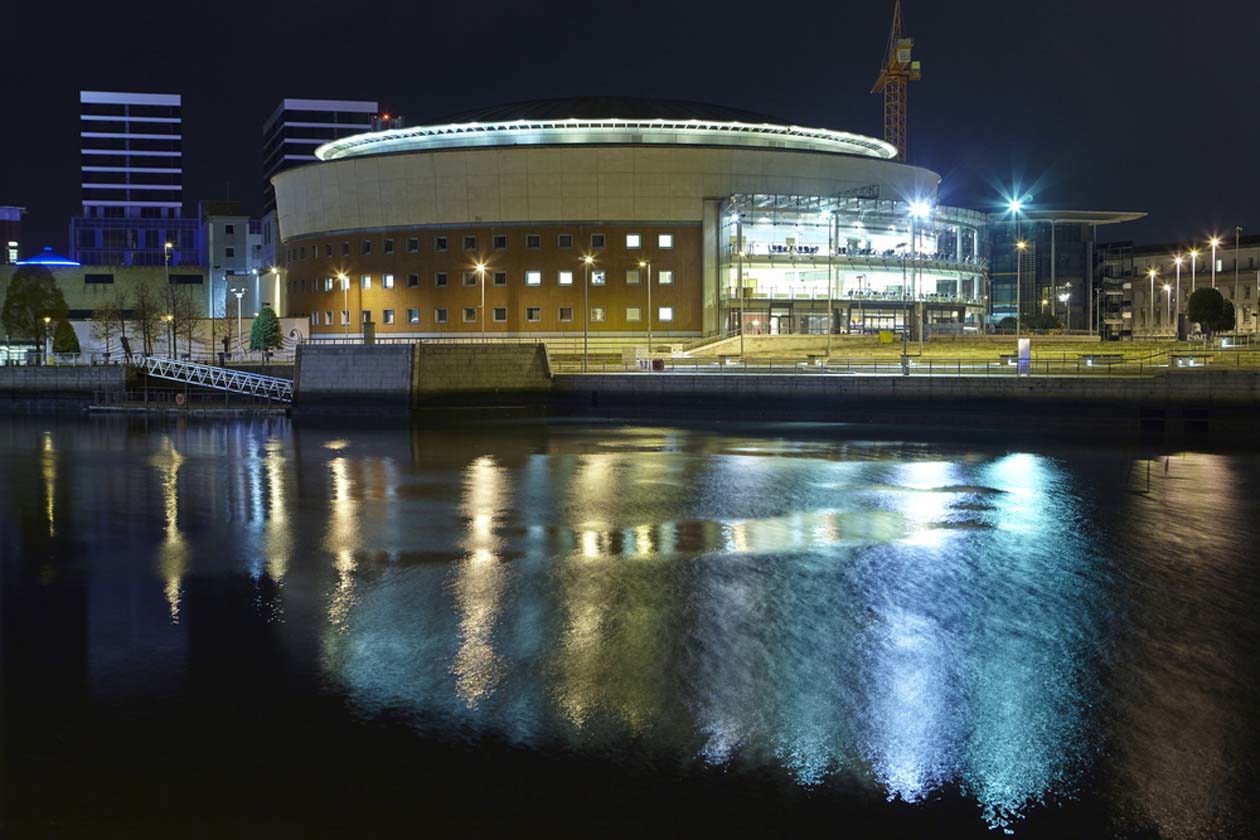
Waterfront Hall on Lagan River, Belfast. Photo: Sisterscom.com, Shutterstock
Along the river Lagan stands Waterfront Hall, the world-class concert and conference centre, together with a series of tall buildings. A sculpture in the form of a fish, the so-called Big Fish, was commissioned to celebrate the regeneration of the Belfast river and is the starting point for fishing trips. Magnificent parks follow the course of the river and lush vegetation surrounds the city.
Belfast was one of the main driving forces behind the industrial revolution, which around the middle of the nineteenth century resulted in the flow of thousands of Irishmen from the countryside to the city looking for work. Between 1851 and 1911, the population quadrupled. The extraordinary growth of Belfast occurred thanks to the great naval and engineering industries.
Titanic
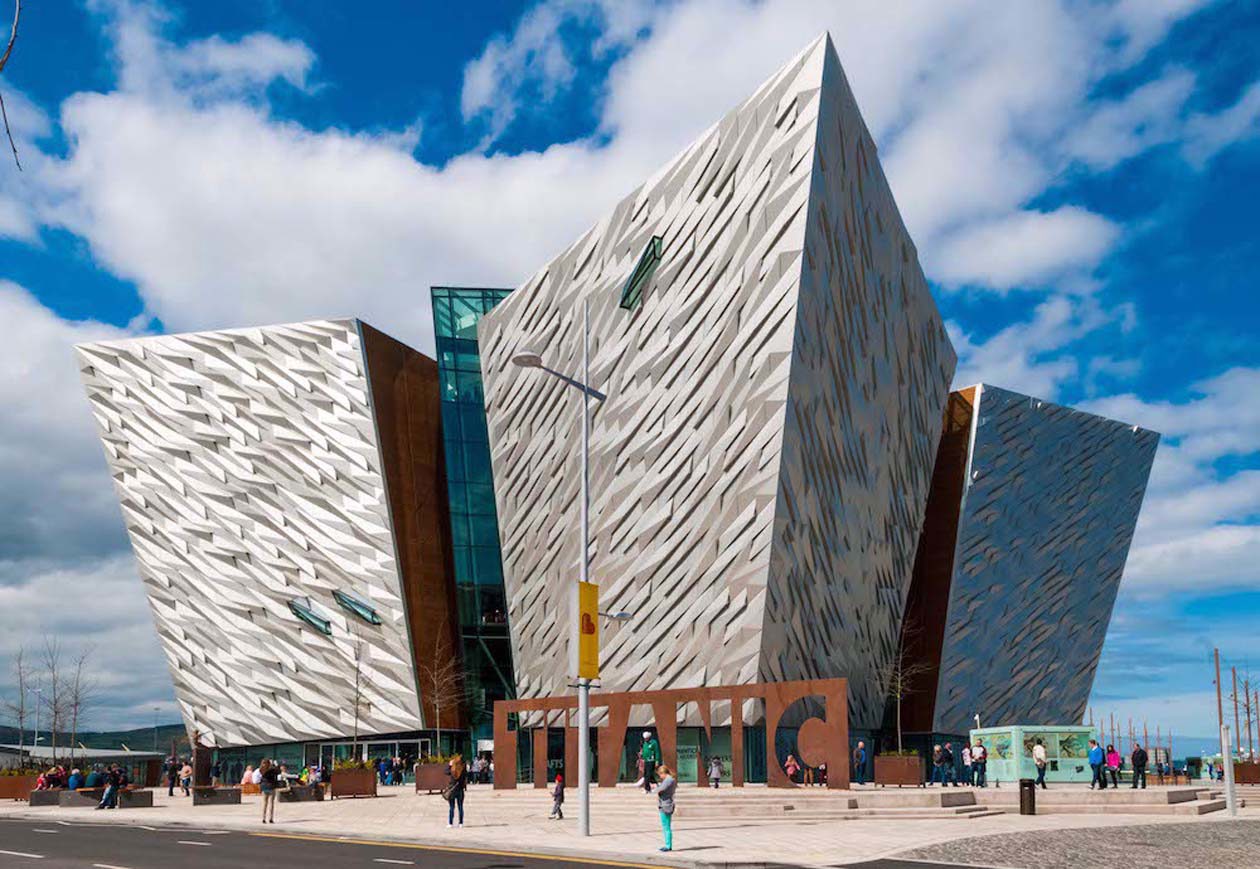
Titanic museum, Belfast. Photo: Sisterscom.com, Shutterstock
The Titanic was built and launched in the Harland & Wolff shipyard, and the city hosts an exhibition dedicated to this magnificent protagonist of the tragic maritime disaster consisting of more than 600 images and a multimedia tour.
Symbols of the industrial heritage are the mills on the banks of the river and the remains of the first textile factories. Quality weaving is still an Irish specialty.
Shopping in Belfast
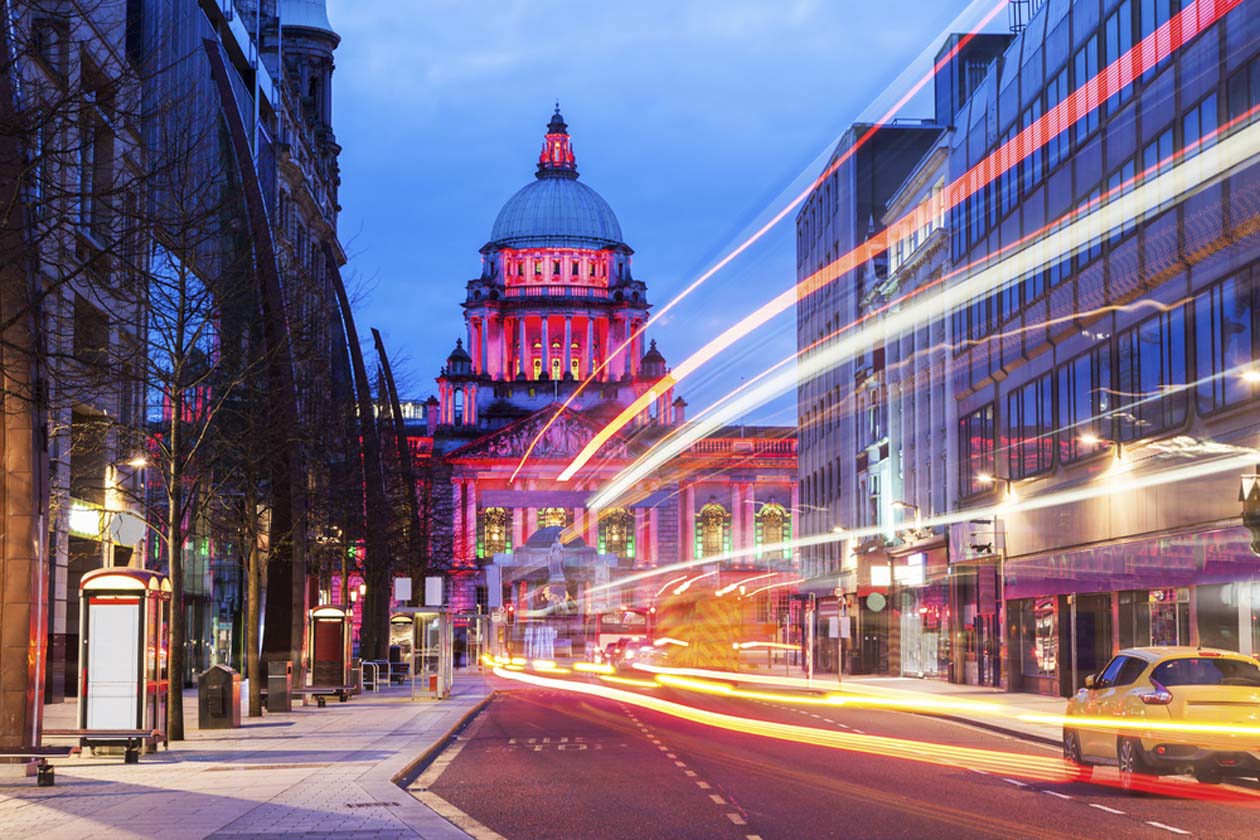
Belfast. Photo: Sisterscom.com, Shutterstock
When shopping in the city of Belfast, look for handmade damask linen and tweed. Other renowned places include City Hall, Wellington Place, Bedford Street and Lisburn Road. After Belfast City Hospital, a large yellow building, fashionable boutiques and stores selling antique clothes alternate with small shops selling craft products, private art galleries, coffee shops, wine shops and traditional pubs offering special beers and live music. Don’t miss the historical Friday morning St. George’s Market and the Food and Garden Market on Saturdays.
Nightlife in Belfast revolves around its famous pubs and clubs, while in the Queen’s Quarter, in the university area, there are fashionable spots such as Shine and Empire, specialising in live bands.
Text by: Angela Trivigno
Avion Tourism Magazine
Photos for editorial use only: Copyright © Sisterscom.com, Shutterstock
All rights reserved. Copyright © Sisterscom.com
Video: titanicbelfast.com
Tourist Offices
www.ireland.com
www.visitbelfast.com
Partnership with Booking.com
Where to sleep in Belfast
Belfast is a welcoming city and offers different possibilities for accommodation.
To find the ideal hotel and the best offers you can do a search for the stars but also for districts or landmarks.
LANDMARKS
Hotels in tourist areas
AIRPORT
Hotels near the airport
WHERE TO GO in belfast
Monuments in Belfast

Copyright © Sisterscom.com / Shutterstock
BELFAST CATHEDRAL
Belfast Cathedral, also known as St. Anne's Cathedral, dates back to 1899 and is a Christian place of worship located in the historic heart of Belfast: the Cathedral Quarter. The Cathedral houses mosaics by the sisters Gertrude and Margaret Martin, stone carvings by sculptors Rosamond Praeger, Morris Harding, and Esmond Burton, stained glass windows, and the Chapel of the Holy Spirit. The 40-meter steel Spire of Hope was added in 2007.

Copyright © Sisterscom.com / Shutterstock
BELFAST CITY HALL
The Belfast City Hall, which opened in 1906, is located in Donegall Square and is distinguished by its ancient stained glass windows in the Grand Staircase, East Staircase, Principal Rooms, or Chamber, depicting Celtic legends and myths, such as the Cattle Raid of Cooley. The new City Hall was designed by Alfred Brumwell Thomas in the Baroque Revival style and constructed from Portland stone. In the City Hall grounds, visitors can explore the Titanic Memorial Gardens, where bronze plaques bear the names of those who perished aboard the Titanic.

Copyright © Sisterscom.com / Willy Barton / Shutterstock
OPERA HOUSE IN BELFAST
Since 1895, the Grand Opera House has hosted some of the most prominent names in theater and music. Designed by theater architect Frank Matcham, it is Northern Ireland's most significant theater, offering a diverse program including opera, theater, pantomime, comedy, and musicals. The original façade, expanded in 2006, is accompanied by a smaller performance space called the Baby Grand Studio.

Copyright © Sisterscom.com / Shutterstock
QUEEN UNIVERSITY IN BELFAST
Queen's University Belfast was established by Royal Charter in 1845 and is one of the leading universities in the United Kingdom and Ireland. It is also known as the Lanyon Building, named after the architect Sir Charles Lanyon who designed the main structure, the Lanyon Building. The heart of Queen's University is this original building, completed in 1849. The architecture features a blend of Gothic and Tudor styles, reminiscent of the great medieval universities, such as Magdalen College, Oxford.
Museums in Belfast

Copyright © Sisterscom.com / Robert Mullan / Shutterstock
TITANIC BELFAST
Titanic Belfast is not just a museum but also a monument to Belfast's maritime heritage. Located on the site of the former Harland & Wolff shipyard in the city's Titanic Quarter, where the RMS Titanic was built, it features galleries, interactive exhibitions, an underwater cinema, a restaurant, and a shop. Visitors can explore the legend of the Titanic and visit the original tender, RMS SS Nomadic.

Copyright © Sisterscom.com / riccar / Shutterstock
METROPOLITAN ARTS CENTRE BELFAST
The Metropolitan Arts Centre Belfast (MAC), which opened in 2012 in Belfast's Cathedral Quarter, is a hub for music, theatre, art, dance, documentaries, art exhibitions, and performances. It features a theatre known for its excellent acoustics and unique architecture. Visitors can also explore various art galleries, the sculpture "The Permanent Present" by Irish artist Mark Garry, and enjoy dining at the restaurant Native by Yellow Door.

Copyright © Sisterscom.com / Claudio Divizia / Shutterstock
ULSTER MUSEUM
At the Ulster Museum, visitors can explore a diverse collection including fossils, dinosaur bones, and Asian, African, European, and Pacific art, along with the famous Egyptian mummy, Takabuti. The permanent galleries feature historical artifacts, natural history exhibits, and collections of Irish art, encompassing sculptures, works on paper, contemporary art, fashion, ceramics, glass, silver, and furniture. The history galleries provide a narrative of the Irish people's story.
Excursions in Belfast and surroundings

Copyright © Sisterscom.com / Shutterstock
CAVE HILL COUNTRY PARK
Cave Hill Country Park, located just minutes from Belfast Zoo, is an ideal spot for outdoor activities, featuring five caves along the Belfast cliffs, various trails, and a play area. The park includes the 19th-century Belfast Castle and McArt's Fort, situated atop the basaltic outcrop known as Napoleon's Nose. This ancient stone fort offers stunning views. The shape of Cave Hill resembles a sleeping giant guarding Belfast, and it is said to have inspired Jonathan Swift's character Gulliver in 'Gulliver's Travels'.

Copyright © Sisterscom.com / Shutterstock
BELFAST CASTLE
Belfast Castle, designed in the Scottish Baronial style, dates back to the late 19th century and was built by the Normans on the slopes of Cave Hill. Inside, the castle features several rooms that reflect its history, including the Shaftesbury Room, the Donegall Room, and the main hall, known as the elegant Chichester Room. This room is distinguished by its polished maple flooring, 18th-century-style wallpaper, chandeliers, and panoramic views. The castle serves as an ideal venue for receptions, conferences, exhibitions, and dinners.

Copyright © Sisterscom.com / Shutterstock
CAUSEWAY COASTAL ROUTE
The Causeway Coastal Route can be explored by renting a car or using public transportation. It stretches for 243 kilometers from Belfast to Derry~Londonderry, offering breathtaking views, towering cliffs, cozy pubs, and unique landscapes. Highlights along the route include the Gobbins Path, Carrick-a-Rede Rope Bridge, Giant's Causeway, cliff walks, and bridges spanning the ocean.

Copyright © Sisterscom.com / Shutterstock
STRANGFORD LOUGH
Strangford Lough is an area of outstanding natural beauty located just 20 minutes from Belfast. The green meadows along the shores of this "inland sea" in County Down are stunning. The landscape features waters teeming with wildlife, hills, sacred springs, and ancient abbeys. It is a natural biodiversity hotspot where one can admire birds, badgers, seals, starlings, and hills covered with gorse, wild thyme, yarrow, and sorrel.
Partnership with GetYourGuide
Tours and excursions
News & Useful info
Shopping
You might be interested in
Destinations found in the vicinity
Other destinations
Airports nearby Belfast

